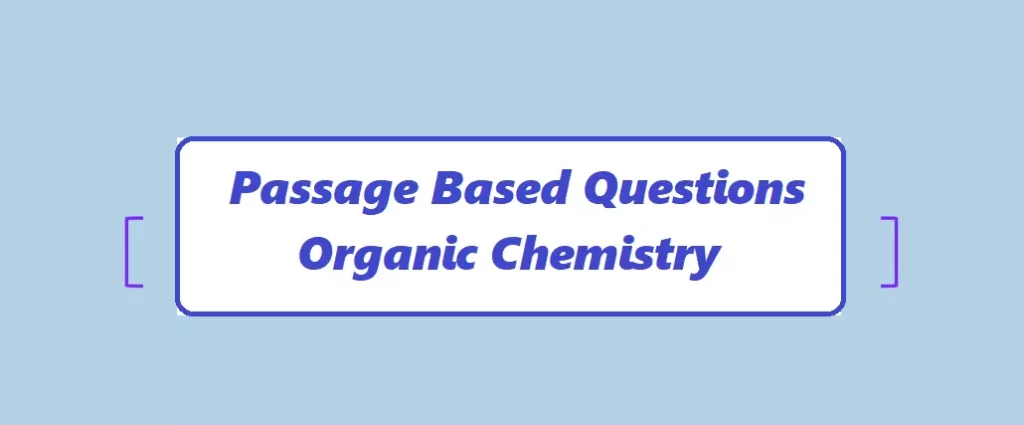Passage Based Questions Organic Chemistry
1. Read the passage given below and answer the following questions:
Oxidation of alcohols to aldehydes is partial oxidation; aldehydes are further oxidized to carboxylic acids. Conditions required for making aldehydes are heat and distillation. In aldehyde formation, the temperature of the reaction should be kept above the boiling point of the aldehyde and below the boiling point of the alcohol. Reagents useful for the transformation of primary alcohols to aldehydes are normally also suitable for the oxidation of secondary alcohols to ketones.

The following questions are multiple-choice questions. Choose the most appropriate answer:
(i) Which of the following alcohols can be obtained from HCHO?
a) Methanol
b) Ethanol
c) Propanol
d) All of these
Ans (i). d) All of these
(ii) Ethanol can be converted into ethanal by:
a) Catalytic hydrogenation
b) Treatment with LiAlH4
c) Treatment with pyridinium chlorochromate
d) Treatment with KMnO4
Ans (ii). CH3CH2OH can be converted into CH3CHO by treatment with pyridinium chlorochromate.
Primary alcohols on oxidation give aldehydes. Further oxidation of aldehydes in the presence of strong oxidizing agent give To stop the oxidation at aldehyde stage and to prevent further oxidation to carboxylic acid, a mild oxidizing agent such as pyridinium chlorochromate or pyridinium dichromate is used.
OR
(ii) The compound that gives a tribromo derivative on treatment with bromine water is:
a) m-Cresol
b) Benzyl alcohol
c) o-Cresol
d) p-Cresol
Ans (ii). a) m-Cresol
(iii) Which of the following species can act as the strongest base?
a) Hydroxide
b) Alkoxide
c) Phenoxide
d) m-Nitro phenoxide
Ans (iii). b) Alkoxide
(iv) Arrange the following compounds in increasing order of boiling point: Propan-1-ol, butan-1-ol, butan-2-ol, pentan-1-ol.
a) Propan-1-ol, butan-2-ol, butan-1-ol, pentan-1-ol
b) Propan-1-ol, butan-1-ol, butan-2-ol, pentan-1-ol
c) Pentan-1-ol, butan-2-ol, butan-1-ol, propan-1-ol
d) Pentan-1-ol, butan-1-ol, butan-2-ol, propan-1-ol
Ans (iv). a) Propan-1-ol, butan-2-ol, butan-1-ol, pentan-1-ol
Passage Based Questions Organic Chemistry
2. Read the passage given below and answer the following questions:
Aldehydes and ketones are especially susceptible to nucleophilic addition because the carbonyl group is polar. A positive charge on carbonyl carbon makes it reactive towards the nucleophile addition reaction. This addition is catalyzed by acid. The greater the electron deficiency at carbonyl carbon greater is nucleophilic addition reactivity. Thus –I groups increase while +I groups decrease the reactivity of carbonyl compound. The following questions are multiple-choice questions. Choose the most appropriate answer:
i) Which of the following is most reactive to give nucleophilic addition?
a) FCH2CHO
b) ClCH2CHO
c) BrCH2CHO
d) ICH2CHO
Ans (i). a) FCH2CHO
ii) Carbonyl compounds show nucleophilic addition with
a) HCN
b) NaHSO3
c) CH3OH +HCl
d) All of these
Ans (ii). d) All of these
iii) Which of the following carbonyl compounds is most polar?
a) Acetone
b) Butanone
c) Ethanal
d) Methanal
Ans (iii). d) Methanal
iv) Select the least reactive carbonyl compound for nucleophilic addition reaction.
a) Benzophenone
b) Acetophenone
c) Benzaldehyde
d) Ethanal
Ans (iv). d) Ethanal
OR
Which among the following isomeric compounds is most reactive?
a) Pentanal
b) Pentan-2-one
c) Pentan-3-one
d) All are equally reactive
Ans. All are equally reactive
Passage Based Questions Organic Chemistry
3. Read the passage given below and answer the following questions:
The dehydration of phenols and alkylation of phenols by alcohols over thorium were studied at 400–500 °C and atmospheric pressure. Phenol and cresols, when dehydrated gave diaryl ethers as main products. With para-substituted phenols such as p-methoxy, p-t-butyl, p-chloro, and p-nitrophenol no ether formation was noticed. All the reactions were accompanied by a considerable amount of coke formation. Alkylation of phenols by alcohols gave a mixture of O- and C-alkylated products under the same reaction conditions. O-alkylation and C-alkylation are parallel reactions.
In addition to acting as an antiseptic, phenol is also a useful precursor in many chemical syntheses to produce pharmaceuticals, food preservatives, polymers, resins and adhesives. Phenolics are also present in a number of biological systems and natural products such as neurotransmitters, flavoring agents, and vitamins to name a few.
The following questions are multiple-choice questions. Choose the most appropriate answer:
i) What is the IUPAC name of Cresol?
(a) 2-Methylphenol (b) 3-Methylphenol
(c) 4-Methylphenol (d) 2,4-Dimethylphenol
Ans (i). (b) 3-Methylphenol
ii). p-Nitrophenol is more acidic due to:-
(a) +R & +I effect (b) –R & +I effect
(c) –I & +R effect (d) -I & -R effect
Ans (ii). (d) -I & -R effect
iii). When Phenol is reacted with CHCl3 and Aq. KOH it gives:-
(a) Salicylaldehyde (b) Crotonaldehyde
(c) Salicyclic acid (d) Cinnamic acid
Ans (iii). (a) Salicylaldehyde

iv). The reaction used to prepare Salicyclic acid from Phenol and CO2 at 5-& atm. is–
(a) Willamson’s reaction (b) Kolbe’s reaction
(c) Reimer Tieman reaction (d) Friedel – Craft reaction
Ans (iv). (b) Kolbe’s reaction

Passage Based Questions Organic Chemistry
4. Read the passage given below and answer the following questions:
Alcohols, phenols, and ethers are widely used in our day-to-day life. Alcohols are classified as mono, di, tri, or polyhydric alcohols. Monohydric alcohols are further classified as primary, secondary, tertiary, allylic, vinylic, and benzylic alcohols. Alcohols can be prepared by various methods e.g. acid-catalyzed hydration of alkenes, reduction of carbonyl compounds, reduction of carboxylic acids, and the reaction of Grignard’s reagent with carbonyl compounds. On comparing the acidity of phenols and alcohols we find that phenol is more acidic because it gives H+ ion more easily and phenoxide ion gets stability due to resonance. Alcohols can be transformed into carbonyl compounds by oxidation and dehydrogenation process. Phenols and aromatic ethers are o- & p- directing towards electrophilic substitution reactions.
The following questions are multiple-choice questions. Choose the appropriate option.
(i) With dilute HNO3 at low temperature (298K), phenol gives:
(a) O- nitro phenol
(b) O- & p- nitro phenol
(c) m- nitro phenol
(d) picric acid
Ans (i). (b) o- & p- nitrophenol

(ii) Ethanol on dehydrogenation using Cu based catalyst gives a carbonyl compound “X”. The compound “X” can also be obtained by the ozonolysis of
(a) But-1-ene
(b) Ethene
(c) But-2-ene
(d) Propene
Ans (ii). (d) Propene
OR
Correct increasing order of acidic strength is:
(a) Ethanol<Phenol<p- Cresol
(b) Phenol<Ethanol<p- Cresol
(c) p-Cresol<Phenol<p- nitro phenol
(d) p- nitro phenol<Phenol< p-Cresol
Ans. (c) p-Cresol<Phenol<p- nitro phenol
(iii) Reaction of Propanone with CH3-Mg-Br followed by hydrolysis gives:
(a) Butan-2-ol
(b) 2-Methylpropanol
(c) Propan-2-ol
(d) 2-Methyl-2-propanol
Ans (iii). (d) 2-Methyl-2-propanol

(iv) An alcohol (in excess) when heated with conc. H2SO4 at 413K gives an ether X, which on reacting with an excess of HI gives only Ethyl iodide. The alcohol and ether would be:
(a) Ethanol & Ethoxy ethane
(b) Propanol & Ethoxy ethane
(c) Propanol & Methoxy ethane
(d) Ethanol & Methoxy ethane
Ans (iv). (a) Ethanol & Ethoxy ethane
Passage Based Questions Organic Chemistry
5. Read the given passage and answer the questions that follow:
Alcohols and phenols are the most important compounds used in our daily life. Alcohols are prepared by hydration of alkenes, fermentation of glucose, reduction of aldehydes, ketones, carboxylic acids, and esters. Alcohols are soluble in water. Boiling points increase with the increase in molar mass and decrease with branching. Alcohols on dehydration give alkene at 443K, follow carbocation mechanism. Excess of alcohol at 413K on dehydration with conc. H2SO4 also follows the carbocation mechanism but gives diethyl ether. Alcohols undergo nucleophilic substitution reactions, esterification with carboxylic acids, and derivatives like amides, acid halides, acid anhydride. Phenol is prepared from cumene, diazonium salts, anisole, and chlorobenzene. Phenol is used to prepare salicylaldehyde, salicylic acid, aspirin, methyl salicylate, p-benzoquinone. Phenol undergoes electrophilic substitution reaction at o & p-position. Ethers are functional isomers of alcohols, have low boiling points. Ethers are used as solvents. Unsymmetrical ethers are prepared by Williamson synthesis. Ethers react with HI and undergo SN1 or SN2 mechanism depending upon the stability of carbocation formed. Aromatic ethers like anisole undergo electrophilic substitution at o & p-position.
Que (a). Write IUPAC name of
 Ans (a). 2-methyl butan-2-ol
Ans (a). 2-methyl butan-2-ol
Que (b). Out of tert, butyl alcohol and n-butanol, which will undergo dehydration faster and why?
Ans (b). Tertiary butyl alcohol will undergo dehydration faster because 3° carbocation is more stable.
Que (c). Convert phenol to p-benzoquinone.
Ans (c).

Que (d). Complete the chemical reaction:

Ans (d).

Que (e). Why is C—OH bond length in CH3OH longer than C—OH bond length in phenol?
Ans (e). It is due to resonance in phenol, there is a double bond character in C—O bond, therefore shorter than the single bond in methanol.
Que (f). Identify the product:

Ans (f).

Que (g). Why is the R – O – H bond angle in alcohol less than tetrahedral bond angles?
Ans (g). It is due to the repulsive interaction between two lone pairs of electrons in alcohol.
Passage Based Questions Organic Chemistry



